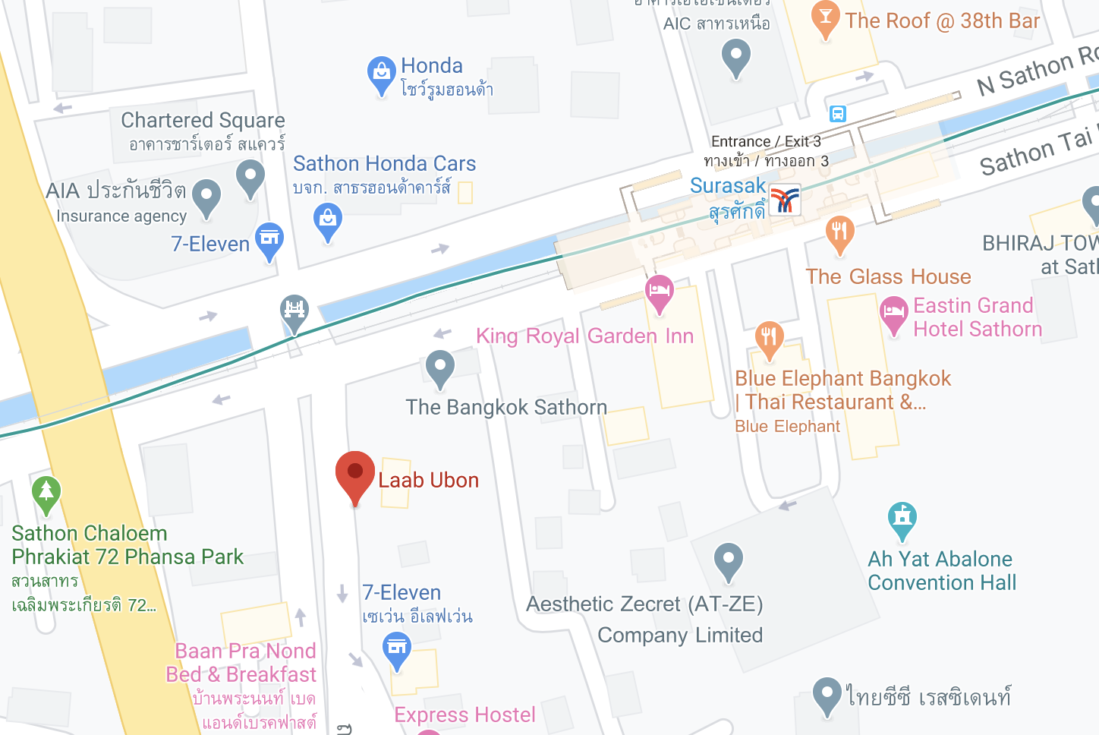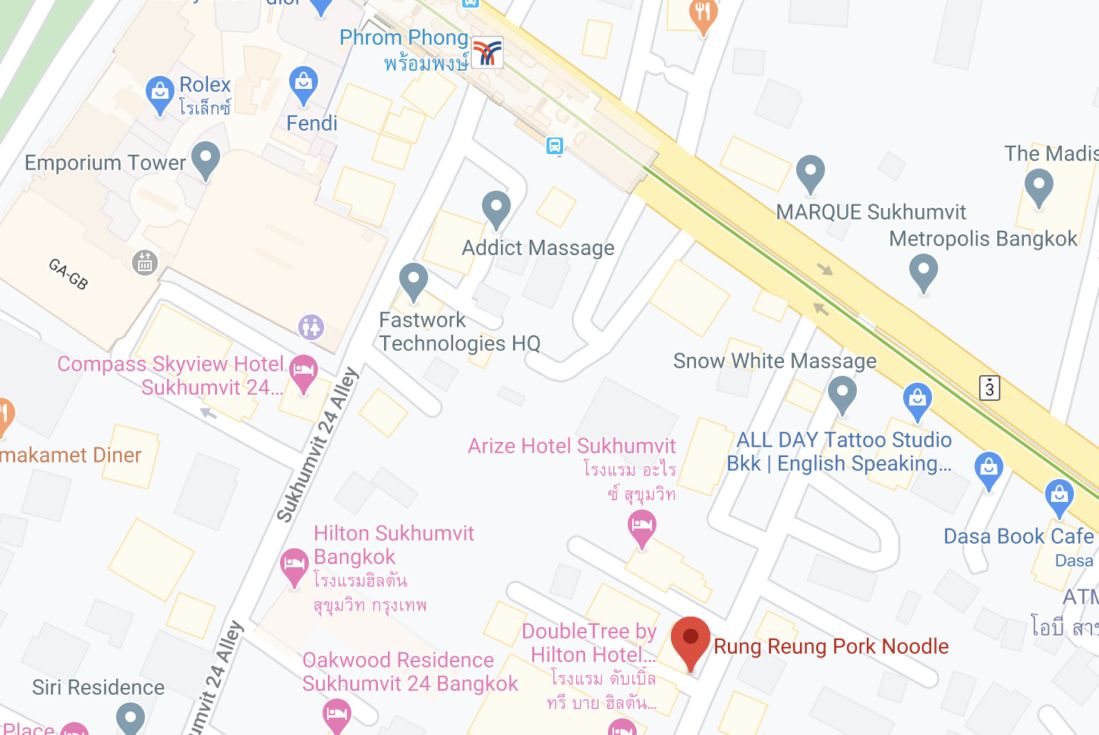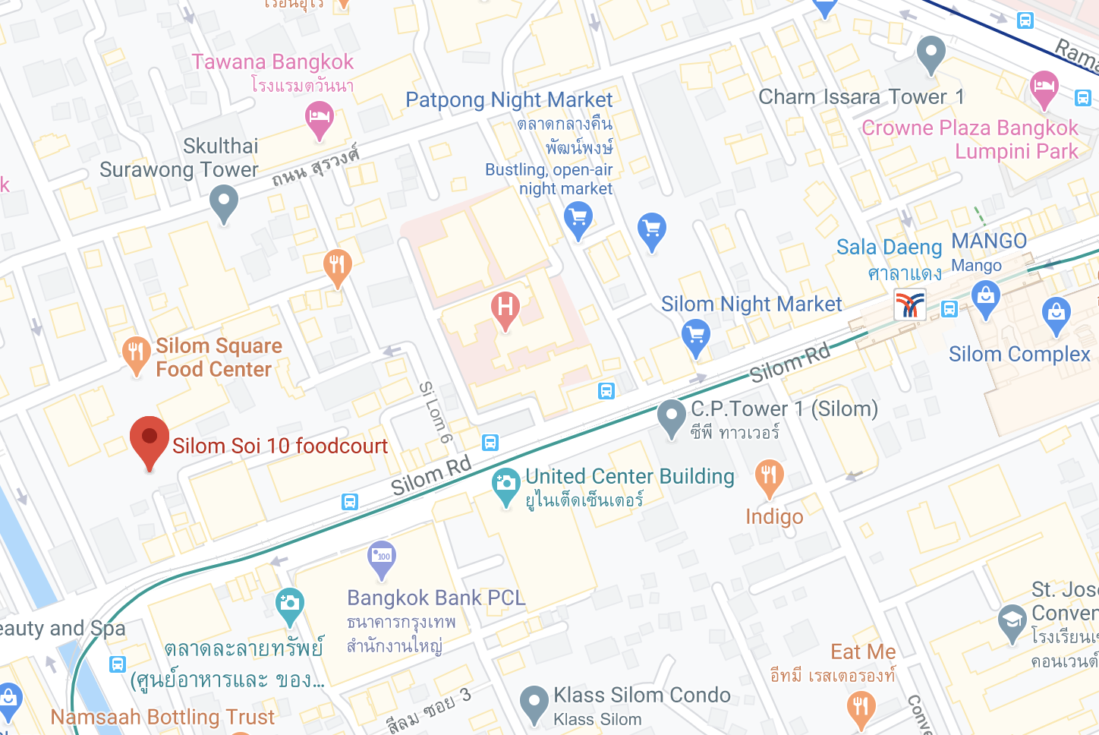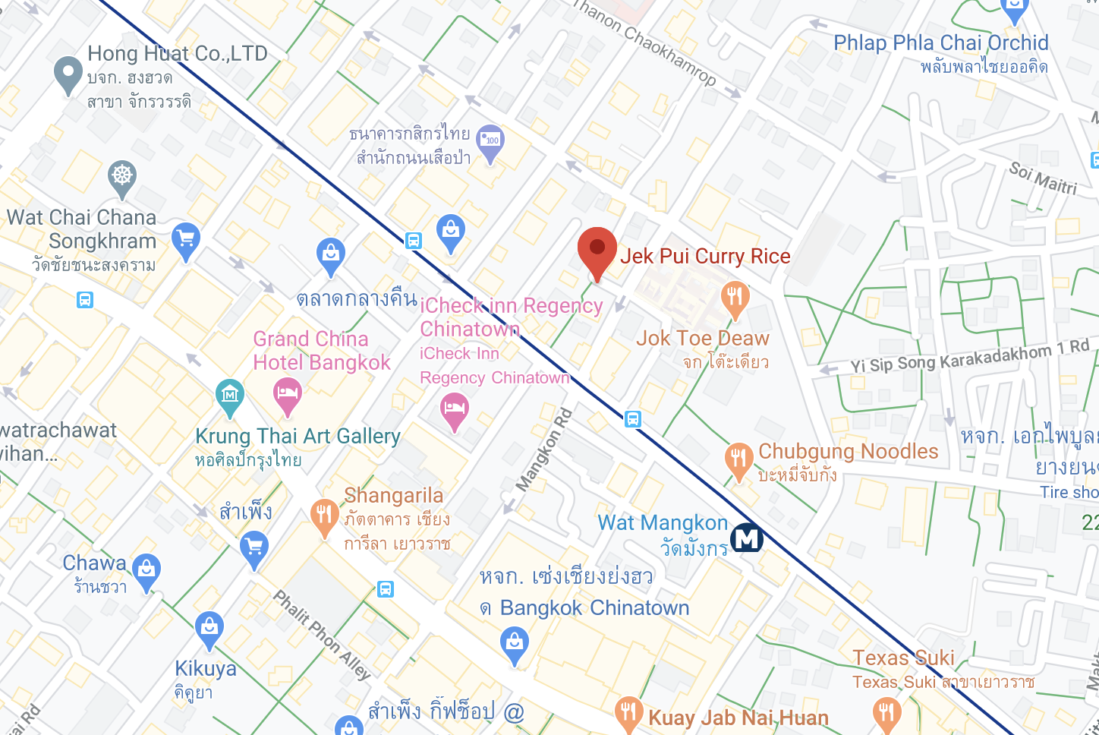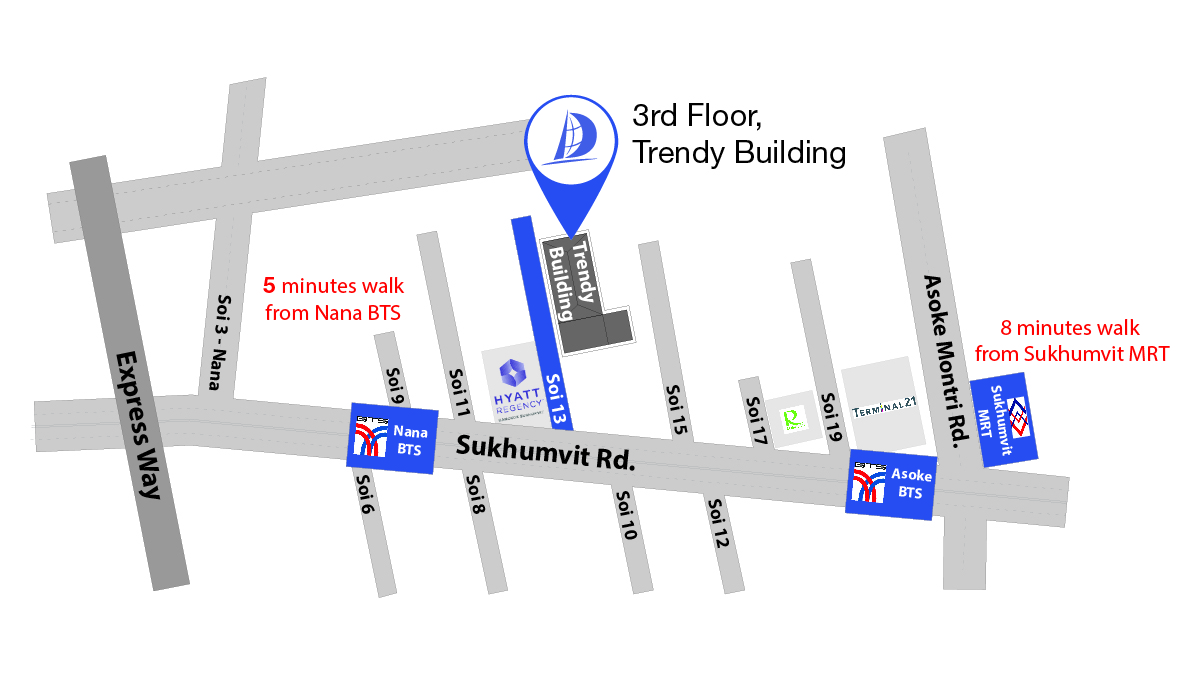6 Cheap Spots In Bangkok For Delicious Thai Food
Ask anyone who’s ever heard of Bangkok to tell you what they know about it and chances are, delicious street food will be one of the first things that will pop into their minds. From the mountainous North to the central plains to the South, Thailand is ideally situated on ancient trade routes, both land and sea, which has ensured the development of a fantastic array of local cuisines, enjoyed by Thais and foreigners alike.
There is certainly no shortage of cheap and delicious meals to be found on the streets of the city from every corner of the country. In fact, during meal times you can be hard pressed to walk 50 metres without coming across a food vendor of some description. On top of the variety and abundance of such delicious food is the fact that in some places you can enjoy an amazing meal for as little as ฿35 or a little over a dollar… not bad for such a treat. Where else in the world can you find such value for money?
Whilst learning the Thai language here in Bangkok, it’s always a good idea to get out and try new places to eat and to taste new dishes, so with this in mind, let’s take a look at 6 of the best cheap Thai restaurants in the city, with a few helpful suggestions from our wonderful Thai teachers who make it so much fun to study Thai in Bangkok.
1. Laab Ubon

Source: laabubon.business.site/posts/6619467081209539436
With a third of Thailand’s 69-million-strong population originating from the roughly Cambodia-sized region of Isan, it’s little wonder that North-Eastern cuisine can be found on the streets of the Thai capital in abundance.
As is traditional in the North-East, the best way to properly experience Isan food is by ordering up a tonne of different dishes and sharing them with a group of friends… the more people you bring to the table, the more culinary variety you can add to your meal. It’s very common to find this place full of bustling energy and local life, complemented by the traditional music of the rural North-East.
Kruu Bingo recommends his favourite, the ต้มแซ่บหมู [dtôm sɛ̂p mǔu] “Spicy Tom Yum Soup” (฿60), but if your tolerance for spice isn’t great, you can specify how many chillies you’d like to be added to your meal by saying:
ใส่พริก ______ เม็ดเท่านั้นนะครับ/คะ
sài prík ______ mét tâonán ná kráp/ká
With only ______ chilli(es), please.
All you have to do is say your ideal number of chillies where the blank space appears… even if this number is 0! In this kind of situation, learning Thai can really help if you’re worried about burning your insides, or if you’re a spice junkie, it can help you step up your game.
Laab Ubon is great for the dinner crowds and the night owls alike, opening in the late afternoon and keeping their doors open through the night until 3:30am, 7 days a week, and with their extensive menu, you’re spoiled for choice.
Address:
251 6 ถนน สาทรใต้ แขวง ยานนาวา เขต สาทร กรุงเทพมหานคร 10120
2. Rung Reung Pork Noodles

An excellent find in the midst of the upmarket surroundings of Phrom Phong, this popular noodle restaurant is spread across 3 units just a few minutes’ walk from the nearby BTS station. As a foreigner, it can take a while to get used to the noodle cart routine when you first get here, but their user-friendly menu takes the confusion right out of the process with a clear flowchart of steps. First, you choose your noodles, then your meat, and finally, your flavour and the clear meal sizes, S, M or L will cost you just ฿50, ฿60 or ฿70 respectively.
Kruu Faa loves the เส้นใหญ่ต้มยำไก่ [sên yài dtôm yam gài] “Chicken Tom Yum Flat Noodles” (฿50/฿60/฿70) and suggests that while saying “S”, “M” and “L” in English might be enough to be understood, it’s better to properly learn the actual terms, and who better to learn from than our very own Thai teachers. Below are the terms that are specific to this restaurant for regular, extra and super-extra sizes for your bowl, as provided by Kruu Faa:
เอาขนาดธรรมดาครับ/ค่ะ
ao kanàat tammadaa kráp/kâ
Regular size, please.
เอาขนาดพิเศษครับ/ค่ะ
ao kanàat písèet kráp/kâ
Extra size, please.
เอาขนาดพิเศษกว่าครับ/ค่ะ
ao kanàat písèet gwàa kráp/kâ
Super extra size, please.
Open from 8am to 4:30pm, this is an excellent place to grab a delicious and inexpensive meal throughout the day. Despite it getting very busy during the lunch hour, you never have to wait long for your food.
Address:
10 3 Sukhumvit 26 Alley, Khlong Tan, Khlong Toei, Bangkok 10110
10 3 ซอย สุขุมวิท 26 แขวง คลองตัน เขตคลองเตย กรุงเทพมหานคร 10110
3. Silom Soi 10 Food Court
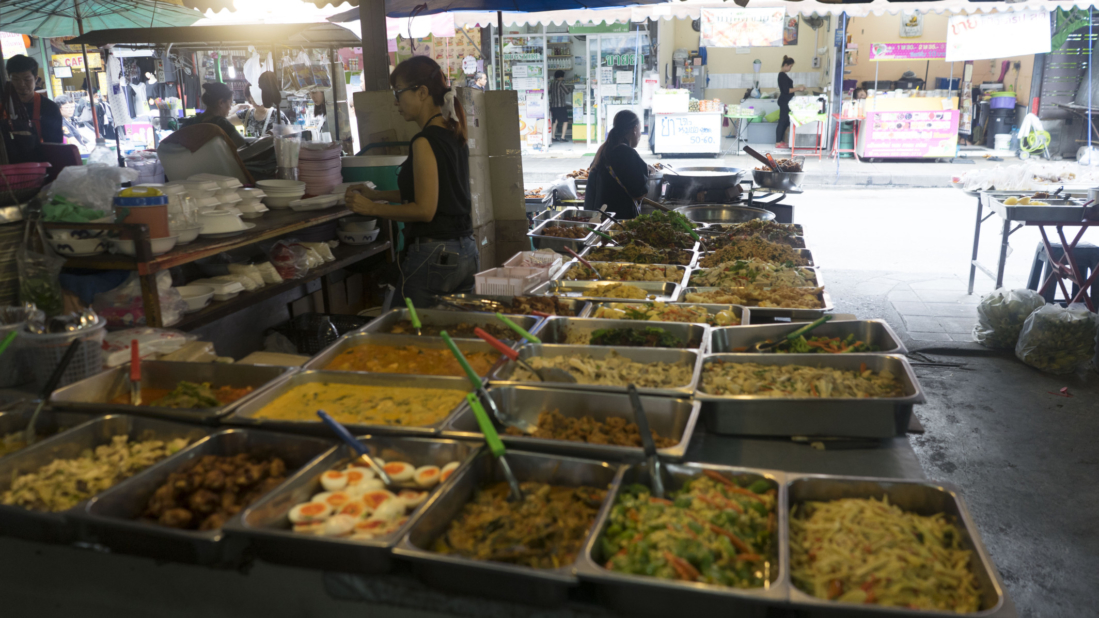
Source: effit-letsgo.com/2016/11/02/silom-soi-10-food-market/#jp-carousel-301
If you can find the narrow unassuming entrance to Silom Soi 10, you might be surprised by what you find inside. Past the clothes market, there’s an unusually broad selection of food stands selling all manner of Thai dishes. Not so much an individual restaurant, but a common seating area surrounded by individual food stands specialising in their own type of food.
Most meals will set you back between ฿40 and ฿80 and the place really peaks at lunchtime when it caters to the crowds of office workers from the surrounding financial district. Among the favourites are the ข้าวมันไก่ [kâao man gài] “Thai-style Chicken and Rice” (฿40), the varieties of ส้มตำ [sôm dtam] “Papaya Salad” (฿40) and the different types of noodle dishes that are available.
Kruu Huda is a big fan of ordering a variety of dishes with friends, but she says that it can get quite crowded during the lunchtime rush, so perhaps before you decide to sit down somewhere, you should check with the people sitting nearby if the seats are already taken:
ที่นี่มีคนนั่งแล้วรึยังครับ/คะ
tîinîi mii kon nâng lɛ́ɛo rʉ́yang kráp/ká?
Is anybody sitting here?
Open from 8am to 3pm, this is more of a lunchtime affair which winds down from 2pm. Well worth checking out if you’re looking for something cheap and delicious but you can’t quite decide what to have: if you take a look around here, chances are you’ll find that certain dish that grabs your attention.
Address:
Soi Naradhiwas Rajanagarindra 1, Suriya Wong, Bang Rak, Bangkok 10500
ซอย นราธิวาสราชนครินทร์ 1 แขวง สุริยวงศ์ เขตบางรัก กรุงเทพมหานคร 10500
4. Jeang Hai
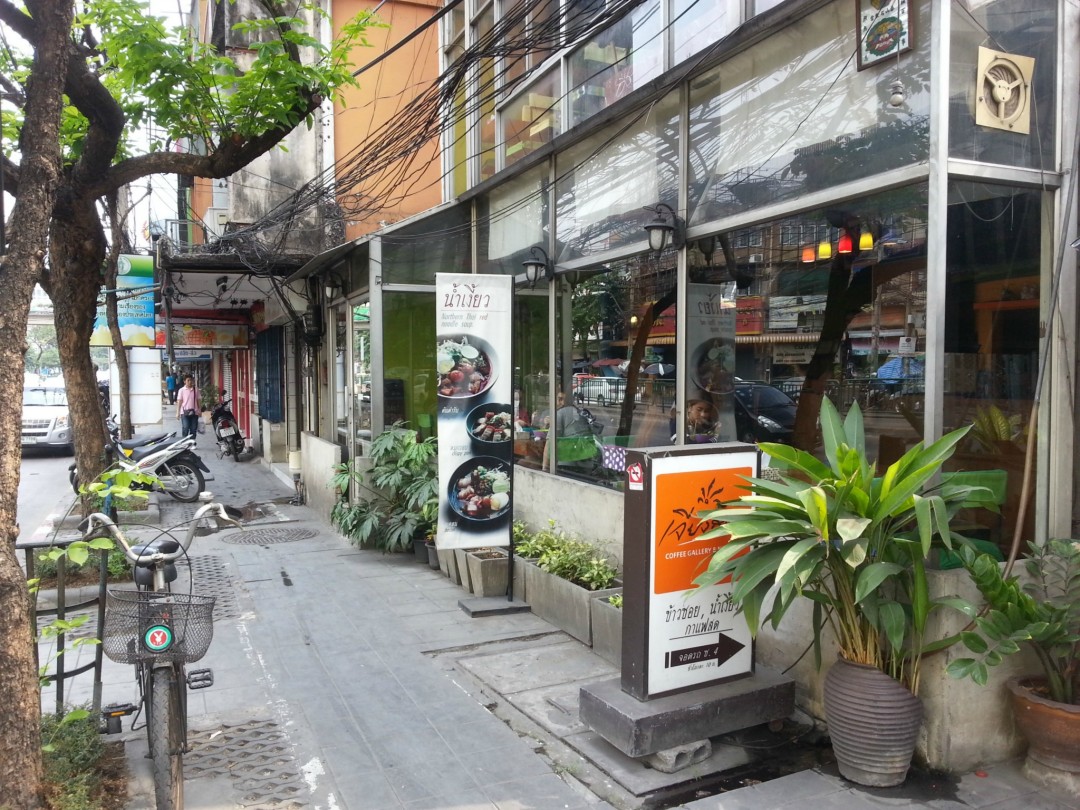
Source: th.openrice.com/th/bangkok/review/ไปแอ่วเจียงฮาย-ไปกิ๋นข้าวซอย-e34339
This hidden gem is the first place you come to as you emerge from exit 1 of Phahon Yothin MRT station, just opposite Union Mall. The first thing that strikes you as you enter is the pleasant ambiance. It’s a small place spread over two floors, but it has a very mellow vibe, with lovely serving staff and an excellent choice of fruit juices and smoothies.
Don’t miss the Khao Soi, the favourite noodle dish of the Northern region, which you can taste for between ฿65 and ฿80. With their foreigner-friendly menu, which includes pictures of all their dishes, you’ll be sure to find the right dish.
Kruu Kik recommends the ข้าวซอยเนื้อ [kâao sɔɔi nʉ́a] “Northern Yellow Curry Noodles with Beef” (฿65) with a delicious fruit smoothie. She also says that the bathroom is a little hard to find in this place [Spoiler: it’s upstairs!], so be sure to learn this phrase by heart:
ห้องน้ำไปทางไหนครับ/คะ
hɔ̂ngnáam bpai taang nǎi kráp/ká?
How do I get to the bathroom?
Once you’ve safely navigated your return down the stairs, don’t overlook the dessert menu, there’s always room when you’re determined enough!
Open from 10:30am to 9:30pm every day, this is an ideal place to drop in to enjoy a good brunch, lunch or dinner whenever you’re in the area without worrying about whether or not it will be open.
Address:
148 Lat Phrao Road, Chom Phon, Chatuchak, Bangkok 10900
148 ถนนลาดพร้าว แขวงจอมพล เขตจตุจักร กรุงเทพมหานคร 10900
5. Pranakorn Noodle Restaurant
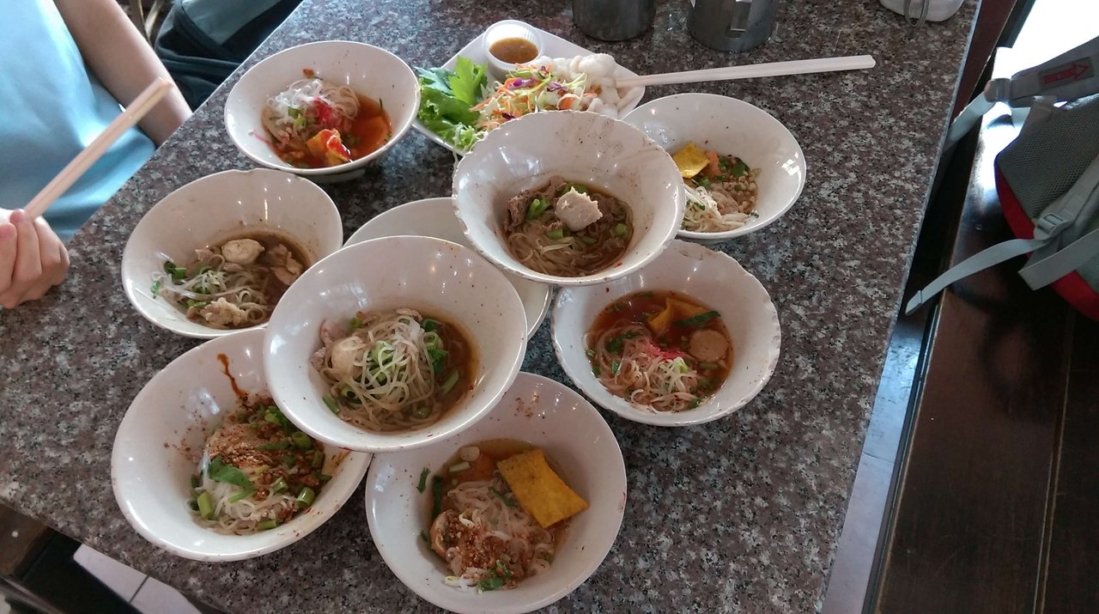
Source: steemit.com/tasteem/@auleo/tasteem-575d10
Ideally located directly north of Victory Monument, this versatile restaurant sells more than just the noodles that its name suggests, from chicken wings to fish rings and lemon pork to fried squid balls. With many dishes being sold for between ฿40 and ฿69, you can enjoy a variety of cheap eats. A highlight here is the selection of noodle mini-bowls you can try for ฿12 each, 3 or 4 of them being roughly equivalent to a full-size bowl. This option means you can order a whole variety of different noodles types without spending much cash or wasting any food.
This place is one of Kruu Aom’s top eateries, with ก๋วยเตี๋ยวน้ำตก [gúaidtǐao náamdtòk] “Meat Soup Noodles” (฿12/฿60) being among her favourites. For those of you who are not a fan of innards, Kruu Aom reminds you that you can always say this to them:
ไม่เอาเครื่องในนะครับ/คะ
mâi ao krʉ̂angnai ná kráp/ká
I don’t want innards.
This term includes everything from liver to intestines, so if you’re not a fan, you can take this advice and just focus on the juicy meaty bits. If this isn’t an excellent practical reason to learn Thai, I don’t know what is.
Easily accessible from the BTS Victory Monument station and via around half of the city’s buses, which pass through the area, Pranakorn is open from 8am to 9pm, Mondays to Sundays, so you can always be sure of finding this place ready to serve you breakfast, lunch or dinner any day of the week.
Address:
Ratchawithi Rd, Thanon Phaya Thai, Ratchathewi, Bangkok 10400
ถนน ราชวิถี แขวง ถนนพญาไท เขตราชเทวี กรุงเทพมหานคร 10400
6. Jek Pui Curry Rice

Source: www.bangkokhappytrip.com/ย่านอร่อยกรุงเทพฯ/ข้าวแกงเจ๊กปุ้ย-ความอ/
Following the recent opening of the MRT Blue Line extension, this place is now more accessible than ever before. Serving a range of heavenly Thai curries and located in an alley opposite Wat Mangkon, this place is the epitome of delicious and authentic street food. With plastic stools scattered around the lane, this venue is certainly not for those seeking a fancy night out, this place is all about the delicious curries served for the dinner crowds just 300 metres from Chinatown’s Yaowarat Road.
With a selection of 10 different curries to choose from, including Stir Fried Crab and Thai red curries, each dish is a very affordable ฿40 for a regular portion and ฿60 for an extra “piset” helping.
This recommendation comes from Kruu Frame, who always chooses the แกงเขียวหวานไก่ [gɛɛng kǐaowǎan gài] “Thai Green Curry with Chicken” (฿40/฿60). If you like to season your Thai curries with fish sauce, chili, vinegar or sugar, know that you won’t readily see any seasoning at your table… because you don’t even have a table! So remember to use this phrase to ask for the collection of seasoning:
หยิบเครื่องปรุงได้ที่ไหนครับ/คะ?
yìp krʉ̂ang-bprung dâai tîinǎi kráp/ká?
Where can I get the seasoning?
Only opening from 3pm to 8pm, you have to time your visit properly. This is an ideal option for those seeking to explore a little of the Chinatown area in the evening and who want to grab a cheap, yet supremely tasty dinner.
Address:
25 Mangkon Rd, Pom Prap, Pom Prap Sattru Phai, Bangkok 10100
25 ถนน มังกร แขวง ป้อมปราบ เขตป้อมปราบศัตรูพ่าย กรุงเทพมหานคร 10100


